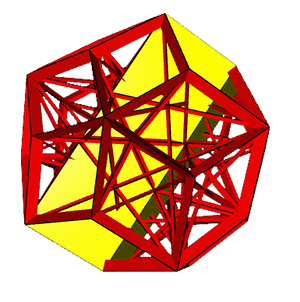



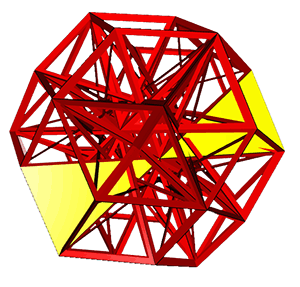
Using Great
Stella, I was able to examine the facetings of the aforementioned
duals
and
identify those meeting my criteria. A
total of twelve crossed-rectangular isohedra were produced. The rhombic
dodecahedron and
medial
rhombic
tricontahedron
produced
two
each,
the
rhombic triacontahedron and great rhombic
triacontahedron produced four each.
Eight of
the new polyhedra can be obtained by faceting the faces of the
rectangular
polyhedra with each rectangular polyhedron giving rise to two
crossed-rectangular
polyhedra. In each case the rectangular
face is replaced by a crossed-rectangular face sharing the same
vertices. These are suffixed ‘a’ and
‘b’ in the list
below. The ‘a’ case has the external
edges of the rectangular polyhedron retained, the ‘b’ case has the
internal
edges retained. It should be noted that the 'a' form for the
crossed-rectangular rhombic dodecahedron is actually a compound of two
polyhedra. Both a single polyhedron and the compound are lined
below.
In the case
of the rhombic triacontahedron and
the great rhombic triacontahedron,
two
further cases can be generated, suffixed ‘c’ and ‘d’.
The faces of these are unrelated to the
rectangular polyhedra or to each other.
In all cases replacing the crossed-rectangular face with a
rectangle or
with the complimentary crossed-rectangle does not result in a valid
polyhedron.
Again the crossed-rectangles can be
difficult to see in the completed polyhedron, so links
are provided below to each polyhedron with one face
hightlighted. The crossed rectangles do not form the 'tubes' as
in the rectangular polyhedra.
For brevity, the term 'Crossed Rectangular' is
shortened to 'XR' in the table below.
Crossed-Rectangular
Rhombic Dodecahedra
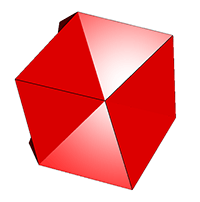
XR rhombic dodecahedron (a)
One highlighted face
Compound
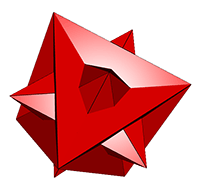
XR rhombic dodecahedron (b)
One highlighted face
Crossed-Rectangular
Rhombic Triacontahedra
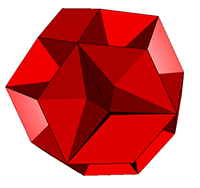
XR rhombic triacontahedron (a)
One highlighted face
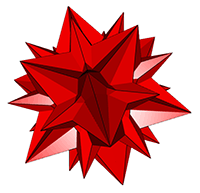
XR rhombic triacontahedron (b)
One highlighted face
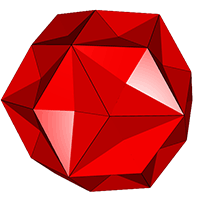
XR rhombic triacontahedron (c)
One highlighted face
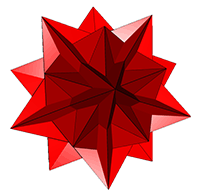
XR rhombic triacontahedron (d)
One highlighted face
Crossed-Rectangular
Great
Rhombic
Triacontahedra
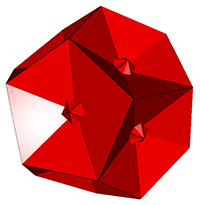
XR great rhombic dodecahedron (a)
One highlighted face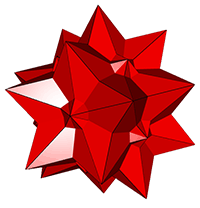
XR great rhombic dodecahedron (b)
One highlighted face
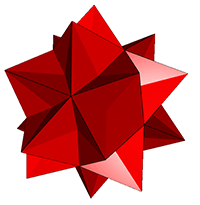
XR great rhombic dodecahedron (c)
One highlighted face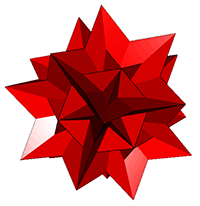
XR great rhombic dodecahedron (d)
One highlighted face
Crossed-Rectangular
Medial
Rhombic
Triacontahedra
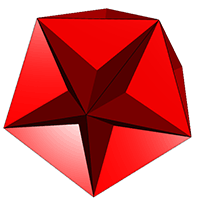
XR medial rhombic dodecahedron (a)
One highlighted face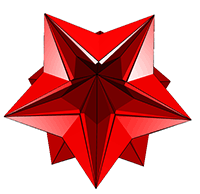
XR medial rhombic dodecahedron (b)
One highlighted face
One further example
can be obtained from the
cube, although in this case the crossed-squares lie in coplanar pairs. Each square of the cube is replaced by two
complimentary crossed-squares. In the image and link below, half
of the
crossed-squares have been highlighted for clarity, although the figure
is isohedral and isogonal and so could be regarded as a somewhat
degenerate noble
polyhedron.
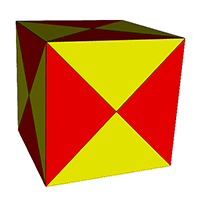 XR cube
|
1. H.S.M. Coxeter and B.Grunbaum , “Face-Transitive Polyhedra with Rectangular Faces” C.R. Math. Rep. Aced. Sci. Canada 20, 16-21, 1998 retrieved from https://www.math.ucdavis.edu/~deloera/MISC/LA-BIBLIO/trunk/Grunbaum2.pdf on 01/09/2025.
2. H.S.M.
Coxeter
and
B.Grunbaum
, “Face-Transitive
Polyhedra with Rectangular
Faces and Icosahedral Symmetry”
Discrete Comput Geom 25: 163-172, 2001 retrieved from https://link.springer.com/content/pdf/10.1007/s004540010087.pdf on 01/09/2025.
3. M. Brückner. "Vielecke und Vielflache:
Theorie und Geschichte". Teubner, Leipzig, 1900. Image retrieved
from https://bulatov.org/polyhedra/bruckner1900/index.html
on 16/09/2025
Back
to index